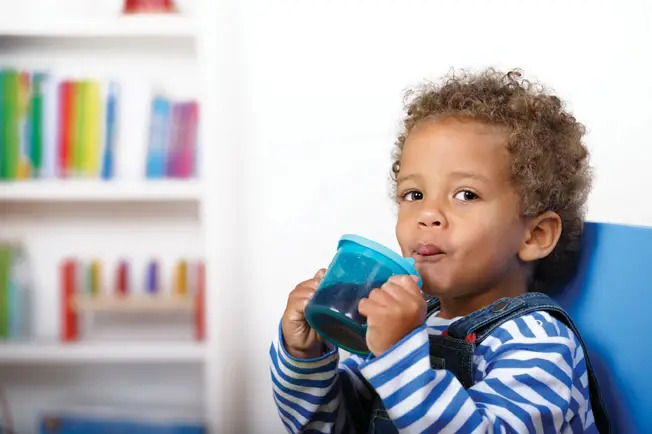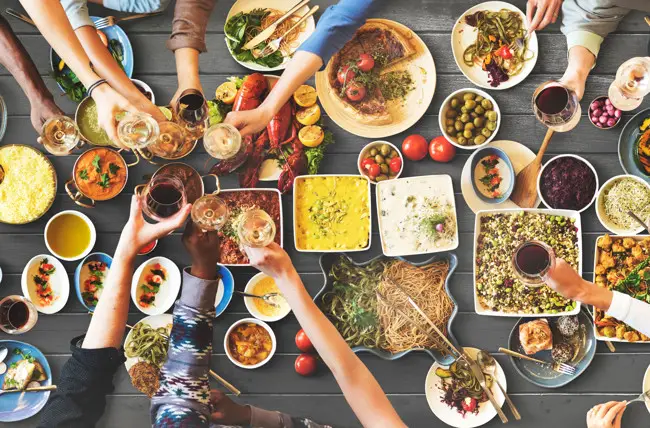Recent studies have show too much fruit juice can contribute to obesity, tooth decay, and poor nutrition in children. Experts weigh in on the nutritional value of this popular beverage.

It’s easy to think that fruit juice is a smart beverage choice for kids. “It’s made of fruit, so it’s good for them, right?” Well, not exactly. According to the American Academy of Pediatrics, too much juice in a child’s diet can contribute to poor nutrition, obesity, and tooth decay.
Nutrition Facts
While it contains little to no fat, the biggest argument against juice is its high sugar content. Fruit drinks that aren’t 100-percent juice typically contain added sugars and/or sweeteners that can increase kids’ calorie intake and up their risk of cavities. Limiting sugary liquids in kids’ diets has become a huge focus in the fight against childhood obesity, and some juices are comparable to soda in their sugar and calorie content. But unlike soda and its complete lack of nutritional value, fruit juice—particularly 100-percent fruit juice—does have some redeeming nutritional qualities.
“Many types of 100-percent juice have nutritional elements,” says Sarah Clark, M.P.H., associate director of the Child Health Evaluation and Research Unit and associate research scientist for the Department of Pediatrics at the University of Michigan. “Orange juice, for example, has vitamin C, potassium, and folic acid. Cranberry juice is thought to protect against bladder infections, and prune juice is said to help digestion. Apple juice, grape juice, and other juices have varying amounts of other nutrients.” Still, Clark says, eating whole fruit is preferable to drinking the juice.
“Juice is not a great habit to get into,” says Keri Glassman, M.S., R.D., C.D.N., founder and president of Nutritious Life in Manhattan. “Drinking a glass of juice will likely not fill up your child as much as eating some fruit, making it easy to over-consume calories from juice. Real fruit provides water volume and fiber, both of which help provide a feeling of fullness.”
Behind the Labels
Understanding juice labels (be it 100-percent juice, juice cocktail, fruit drink, or concentrate) is very important when determining nutritional content. The juice aisle can be overwhelming and confusing, so what exactly should you be looking for? “The key to reading the labels is that it contains 100-percent fruit juice, no additives, is not from concentrate, and is USDA organic,” says Rebecca Meyerson, M.S., founder of Simply Healthy Living in Westchester. “My favorite 100-percent pure fruit juices are orange juice, which is high in vitamin C and potassium; grapefruit juice, second-highest in vitamin C; apricot nectar, high in vitamin A; and prune juice, high in fiber, iron, and zinc.”
100% Juice: “[This] will be your best juice choice—it indicates that this drink is made by squeezing directly from the fruit or vegetable itself, using 100-percent real juice,” Glassman says. “Note that according to FDA rules, anything that contains less than 100 percent juice must be labeled with a qualifying term such as ‘beverage’ or ‘drink’ or ‘cocktail.”
Flavored Fruit Drink: “Anything labeled ‘flavored’ is, well, simply flavored,” Glassman says. “It does not, by FDA regulations, have to contain any fruit juice and doesn’t have to state the percentage—if any—of juice it actually contains. This usually means it is made with artificial flavorings and ingredients and tends to be loaded with added sugars. Stay away.”
From Concentrate: “Many juices are labeled with the qualifying term ‘from concentrate.’ This means that they have been made through a process by which all the excess water has been removed from the original juice, compressed, and then frozen,” Glassman says. “This label will be pretty prominent on the beverage itself so it will be fairly easy to spot. The AAP recommends that kids drink 100-percent fruit juice whenever possible but “from concentrate” juices are an acceptable alternative in moderation, especially because they’ve been pasteurized, which makes it less likely your little one will have diarrhea—a side effect of juice overdose most common in tots ages 2-3.
|
Drink Responsibly The AAP suggests 100-percent fruit juice, in moderation, as an acceptable part of a healthy diet. It offers the following juice recommendations by age groups: Younger than 6 months: Fruit juice should not be given to infants younger than 6 months of age because it offers no nutritional benefit to this age group. Ages 1-6: Limit juice to 4 to 6 ounces per day. The AAP recommends that you do not allow children in this age group to carry a cup or box of juice throughout the day. Ages 7-18: Limit juice to 8 to 12 ounces per day. |
Moderation and Kicking the Habit
Practice what you preach when it comes to moderating juice consumption. “The best thing parents could do is be a healthy beverage role model themselves,” Iacono says. “Parents should have a positive behavior, outlook, and patience when attempting to change previously adopted eating and drinking patterns with their children.”
“For younger kids, a bottle or sippy cup is a comfort item. So it might not be the lack of juice that’s causing a tantrum, but rather taking away the beloved bottle or cup,” Clark says. “Parents can replace the juice with water—and toss in a few ice cubes and allow kids to ‘hear the tinkle’ to distract them.”
Kicking a heavy juice habit does take time. “If kids are drinking straight juice, parents can start slowly, adding just a bit of water and eventually end up with a 50/50 water/juice mix,” Clark says. “Avoid serving juice with meals—too often, kids’ tummies get filled up with beverages. Instead, let kids fill up on food and serve a glass of water if they ask for a beverage. And do not put juice in a bottle.”
“Always have water and low-fat milk available and offer 100-percent juice in recommended, age-appropriate serving sizes,” Iacono says, suggesting that parents limit the amount of juice they buy weekly and understand that it should not be offered as a nutritious drink option.
Not sure your child will be able to drink just plain water? Meyerson recommends flavoring water with raw lemon, lime, cucumber, orange, or watermelon.
Healthier Alternatives
In its second edition of Food Fights: Winning the Nutritional Challenges of Parenthood Armed with Insight, Humor, and a Bottle of Ketchup (March 2012), the AAP recommends that parents serve juice that contains pulp (for added fiber), consider diluting the juice with water, and buy only pasteurized products (shelf-stable juices, frozen concentrates, or specially marked refrigerated juices) to avoid potential diarrhea-causing infections.
Pasteurized apple cider and homemade smoothies are great alternatives to juice. “Choose apple cider over apple juice (yes, even 100-percent juice). Apple cider has a higher concentration of polyphenols (antioxidants) than apple juice, because in processing apple juice the skin and seeds are generally removed,” Glassman says. “Try a fresh fruit smoothie as a delicious—and more nutritious—alternative to fruit juice. You’ll retain some of the fiber and you can easily blend your favorite fruits together, with milk for calcium and protein as well.”
Mary Wheeler is a New York City-based publishing professional, consultant, and lifestyle writer whose work has appeared in “Redbook” and “Hamptons Magazine,” among others.
Also see:




















